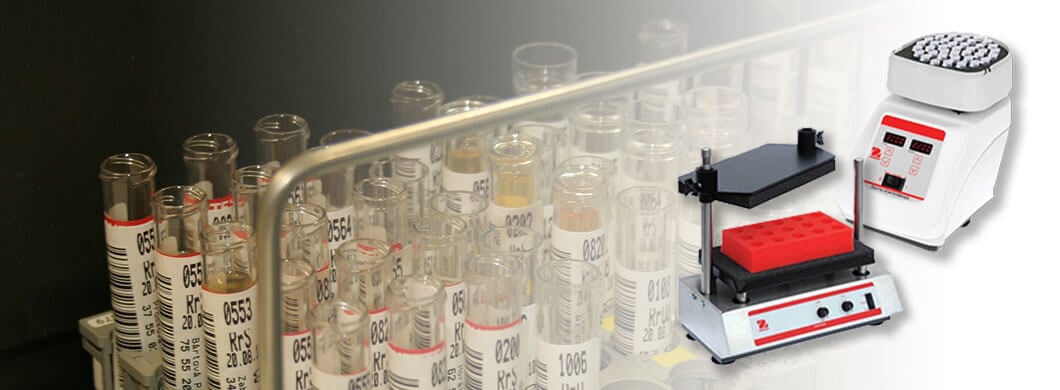Vortex mixers are a necessary piece of equipment for any lab that deals with the combination of liquids, solutions, and suspensions. They utilize technology that delivers blasts of energy to the components, combining them on a cellular level—something centrifuges or similar equipment cannot replicate, as they simply mix the materials together. However, not all vortex mixers are the same. These essential machines are designed to fulfill specific mixing needs, available in analog or digital formats, and can range in speed from 200 to 4500 RPM.
This variety in capabilities is necessary to cover the limitless range of materials found in a laboratory setting and the limitless ways in which those materials can be handled and tested.
Luckily, the models in our extensive catalog can cover virtually any combination task you might need a vortex mixer for – you just need to choose the one that best suits the needs of your lab.
All-Around Mixer
If your lab regularly combines different materials in a variety of unique ways, you’d likely be better served with a vortex mixer that’s less specialized and more suited to admirably tackle a great number of mixing tasks. The Ohaus VXHDDG Heavy-Duty Vortex Mixer fits that bill and then some, as its flexible design allows users to handle materials in a variety of different vessels and mix them at either user-set or digitally-controlled speeds.
Though this model is a little more expensive than similar models in our catalog, its ability to be fitted with a wide range of accessories eliminates the need for other mixers, which may in fact save you money on your overall equipment costs. Those accessories allow the VXHDDG to work with microtubes, microplates and tubes ranging from .5 to 50 milliliters. That flexibility – when combined with its heavy-duty construction and its ability to operate continuously – makes the VXHDDG the workhorse of any lab.
High-Volume Mixer
Speaking of workhorses, certain models of vortex mixers are better suited for high-volume labs that require a large number of samples to be processed with exceptional speed and accuracy. If that sounds like your lab, then look no further than the Ohaus VXMTAL Multi-Tube Vortex Mixer.
Its interchangeable foam racks allow you to simultaneously vortex up to 15 tubes ranging from 10 to 29 millimeters in diameter. You achieve this by securing the top of the sample while the bottom rotates at a manually-set or digitally-controlled speed. Suction cups set into its base anchor the incredible motion of this machine, preventing the VXMTAL from sliding even when operating at full capacity.
Space-Saving Mixer
If your lab’s already crammed to the gills with equipment, the last thing you want to do is introduce another piece of machinery and make things even more crowded. Luckily, the Lab Companion VM-96A Vortex Mixer is designed to fit in even the most cramped of labs, as its low-profile construction and small footprint mean that it can be stored or used just about anywhere.
What’s more, this compact dynamo can be fitted with a wide range of accessories, making it every bit as flexible as it is convenient. That flexibility also extends to its modes of operation, as the VM-96A can operate at touch, continuous, and high-continuous speeds while also boasting dynamic and real-time mixing abilities.
This model is also exceptional for labs running on a tight budget, as its affordable initial purchase price is made all the more attractive by the low amount of maintenance required by its sparkless, quick-accelerating BLDC motor. Looking to match your new mixer to your existing equipment? Lab Companion also manufactures mixers in a variety of other colors including the Orange VM-96TO Vortex Mixer and the Persian Blue VM-96TB Vortex Mixer models that are every bit as stylish as they are efficient and compact.
Mixer for Precision Jobs
Though all laboratory equipment should be precise, some models are simply better at producing repeatable results than others. The Ohaus VXMPDG Microplate Vortex Mixer is one of those models, a microprocessor-controlled piece of precision machinery designed to operate continuously throughout its speed range. Its digital controls allow the user exact and simultaneous command of both the model’s operation speed and its timer, allowing for easy on-the-fly adjustments. Though its high speed and small orbit make the VXMPDG ideal for microplate mixing, it also comes with a cup head accessory to mix components in single tubes when necessary.
Mixers for Your Lab
The models listed above are by no means the entirety of our mixer catalog. Please browse our vortex mixer listings online for our extensive selection of machines and accompanying accessories. Need help deciding which mixer is best for your lab? Please feel free to send us an e-mail. Our knowledgeable customer service associates can help you choose the model that best suits your needs and can recommend other Certified MTP items that can boost the capacities and capabilities of your lab.
A vortex mixer is a simple yet essential laboratory device that extensively mixes small vials of liquid in biological, chemical, and clinical laboratories. It achieves homogenous mixtures efficiently and effectively in a very short time. This 500-word overview provides a comprehensive insight into the vortex mixer, including its design, functionality, applications, benefits, limitations, and evolving features.
Design and Working Principle
A typical mixer consists of a motor with a vertically aligned drive shaft attached to a cupped rubber piece mounted slightly off-center. Pressing a test tube engages the rapid circular motion. It transfers to the liquid, creating a vortex. Thoroughly mixes the contents inside. This simple design is robust and highly effective.
Functionality
The primary function of a mixer is to create a vortex in a liquid sample, ensuring thorough mixing. You can often adjust the speed of the mixer; lower speeds result in gentle mixing, while higher speeds create a more vigorous vortex. Some models offer a “touch mode,” creating a vortex only when you apply pressure to the rubber piece, and a “continuous mode” for longer or unattended mixing sessions.
Applications in Various Fields
Mixers with vortex have a wide range of applications across various scientific disciplines:
1. Biological Sciences: For mixing reagents, cell suspensions, and experimental samples in biochemistry, molecular biology, and microbiology.
2. Clinical Laboratories: Used for mixing blood samples, reagents, and other fluids in clinical diagnostic applications.
3. Chemical Research: Essential for quick and thorough mixing of chemicals and solutions in research labs.
4. Educational Labs: Commonly used in academic institutions for teaching purposes and routine experiments.
Benefits
The mixer offers several advantages:
1. Efficiency: Rapid mixing of samples saves time, especially valuable in high-throughput settings.
2. Ease of Use: Simple operation makes it accessible to users of all skill levels.
3. Uniform Mixing: This creates a homogenous mixture, crucial for the accuracy and consistency of experimental results.
4. Versatility: Can be used with various types of tubes and vials, adding to its practicality in diverse laboratory settings.
Limitations
Despite its numerous benefits, the vortex mixer has certain limitations:
1. Limited Volume: Generally only suitable for small-volume samples.
2. Potential for Cross-Contamination: If not used carefully, there’s a risk of sample spillage and cross-contamination.
3. Physical Stress on Samples: Vigorous vortexing can sometimes be detrimental to delicate samples or cells.
Technological Advancements and Future Trends
Recent advancements in vortex mixer technology include:
1. Digital Control: Enhanced precision with digital speed control and timers for reproducible results.
2. Multi-Tube Capacity: Some modern designs allow for the simultaneous mixing of multiple samples.
3. Noise Reduction: Newer models focus on reducing operational noise, a significant advantage in busy laboratory environments.
Conclusion
The vortex mixer is a staple in many laboratories due to its simplicity, efficiency, and effectiveness. While primarily used for mixing small liquid samples, its versatility accommodates a variety of scientific applications. As laboratory needs evolve, so do the features of vortex mixers, with modern designs offering more control, capacity, and convenience. Despite its limitations, the vortex mixer is essential for research. It plays a crucial role in scientific advancement. Researchers and technicians rely on it.
Certified MTP has an elite selection of lab solutions, showcasing industry-leading brands including Flasks, Beakers, Pipettes, & Graduated Cylinders, Erlenmeyer Flasks, Measuring Pipettes, Stainless Steel Beakers, Glass Graduated Cylinders, and Plastic Graduated Cylinders.
Related Blogs for Vortex Mixers:
Suction Filtration: The Basics of Vacuum Filtration
Aspirator Flask: Benefits of Borosilicate Glass Filter Flask

